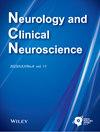Clinical study of six patients with pure dysarthria and dysarthria—(Central) facial nerve palsy/isolated central facial nerve palsy caused by extracerebellar infarction
IF 0.4
Q4 CLINICAL NEUROLOGY
引用次数: 0
Abstract
Abstract Background The corticobulbar tract (CBT) exerts bilateral supply to the cerebral nuclei. The cerebellar motor circuit controls the coordination and regulation of voluntary movements including speech function, and consists of input and feedback pathways including the parietopontine fibers (PPFs) which descend along with the CBT. Aim The pathogenesis of dysarthria caused by ischemic extracerebellar lesions was studied. Methods Six patients with extracerebellar lesions comprising two patients with pure dysarthria, three patients with dysarthria—(central) facial nerve palsy, and one patient with isolated central facial paresis were enrolled. Results Lesions were located in the corona radiata in four patients and the posterior limb of the internal capsule (PLIC) in two patients. Lesions were lateralized on the right side in three patients and the left side in three patients. Lesions in the corona radiata and the PLIC included the middle parts where the CBT exists. Conclusions Based on the hypothesis of bilateral supply to the cerebral nuclei for speech function through the cerebellar motor circuit, it was explicable that unilateral involvement of the PPFs caused dysfunction of the bilateral CBT, which led to the incidence of dysarthria in our case series. Involvement of the PPFs might play a crucial role in the incidence of dysarthria caused by ischemic extracerebellar lesions.单纯构音障碍及构音障碍-(中枢)面神经麻痹/孤立性中枢面神经麻痹6例临床研究
摘要背景皮质球束(CBT)对大脑核施加双侧供应。小脑运动回路控制着包括语言功能在内的自主运动的协调和调节,由输入和反馈通路组成,其中包括随着CBT下降的顶顶在线纤维(ppf)。目的探讨缺血性脑外病变致构音障碍的发病机制。方法6例小脑外病变患者,其中单纯构音障碍2例,构音障碍-(中枢)面神经麻痹3例,孤立性中枢性面神经麻痹1例。结果4例患者病变位于放射冠,2例患者位于内囊后肢。3例患者右侧和3例左侧病变侧化。辐射冠和PLIC的病变包括CBT存在的中间部分。结论基于双侧通过小脑运动回路向脑核提供语言功能的假设,可以解释ppf单侧受累导致双侧CBT功能障碍,从而导致本病例系列中构音障碍的发生。ppf的参与可能在缺血性小脑外病变引起的构音障碍发生率中起关键作用。
本文章由计算机程序翻译,如有差异,请以英文原文为准。
求助全文
约1分钟内获得全文
求助全文

 求助内容:
求助内容: 应助结果提醒方式:
应助结果提醒方式:


